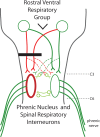Shedding light on restoring respiratory function after spinal cord injury
- PMID: 19893756
- PMCID: PMC2773153
- DOI: 10.3389/neuro.02.018.2009
Shedding light on restoring respiratory function after spinal cord injury
Abstract
Loss of respiratory function is one of the leading causes of death following spinal cord injury. Because of this, much work has been done in studying ways to restore respiratory function following spinal cord injury (SCI) - including pharmacological and regeneration strategies. With the emergence of new and powerful tools from molecular neuroscience, new therapeutically relevant alternatives to these approaches have become available, including expression of light sensitive proteins called channelrhodopsins. In this article we briefly review the history of various attempts to restore breathing after C2 hemisection, and focus on our recent work using the activation of light sensitive channels to restore respiratory function after experimental SCI. We also discuss how such light-induced activity can help shed light on the inner workings of the central nervous system respiratory circuitry that controls diaphragmatic function.
Keywords: C2 hemisection; channelrhodopsin; optogenetics; phrenic nucleus; plasticity; regeneration; respiration; spinal cord injury.
Figures

References
-
- Alilain W. J., Goshgarian H. G. (2008). Glutamate receptor plasticity and activity-regulated cytoskeletal associated protein regulation in the phrenic motor nucleus may mediate spontaneous recovery of the hemidiaphragm following chronic cervical spinal cord injury. Exp. Neurol. 212, 348–35710.1016/j.expneurol.2008.04.017 - DOI - PMC - PubMed
-
- Alilain W. J., Horn K. P., Dick T. E., Silver J. (2006). Chondroitinase ABC-induced reduction of chondroitin sulfate proteoglycans and the perineuronal net following C2 hemisection. Program No. 720.7. Neuroscience Meeting Planner Atlanta, GA Soc. Neurosci., Online.
-
- Alilain W. J., Horn K. P., Dick T. E., Silver J. (2007). Chondroitinase ABC treatment following C2 hemisection results in dramatically enhanced ipsilateral hemi-diaphragmatic recovery. Program No. 137.4. Neuroscience Meeting Planner San Diego, CA Soc. Neurosci., Online.
LinkOut - more resources
Full Text Sources
Miscellaneous

